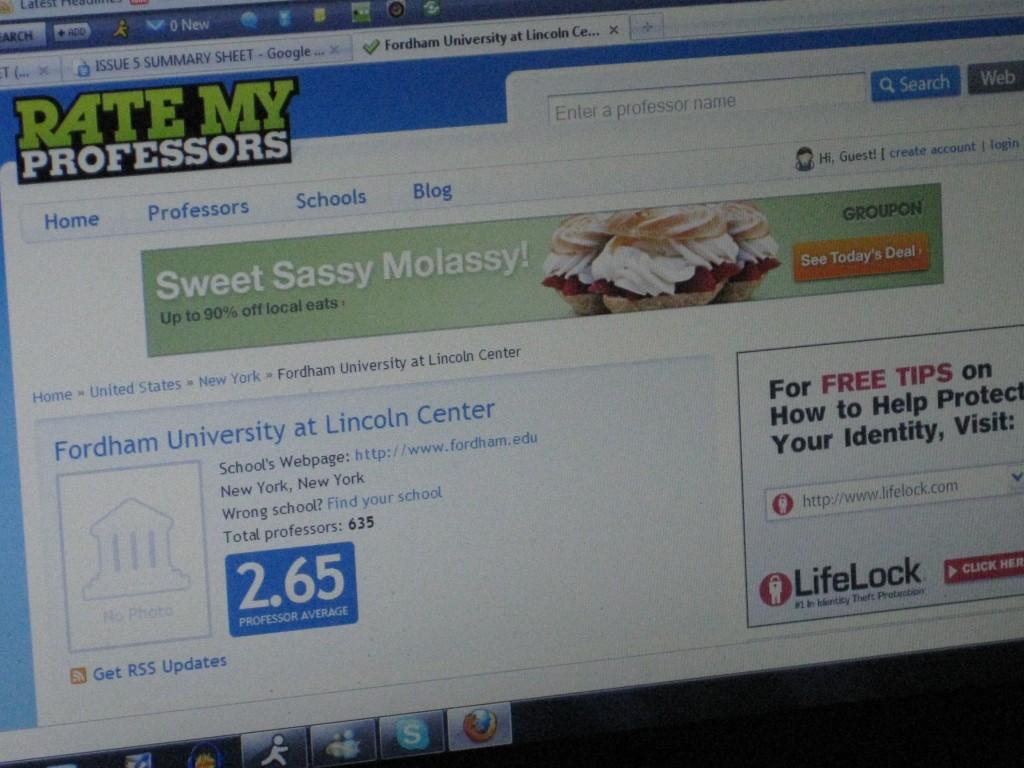FCLC Students and Professors Rate RateMyProfessors.com
August 3, 2011

We have all at some point or another at least heard of, if not used, RateMyProfessors.com, but did you know that Fordham College at Lincoln Center (FCLC) professors score a disappointing 2.65 out of 5.0 on the website?
Ashley Louszko, FCLC ’11, said, “Wow, that number seems really low. In my four years at Fordham I have had really good experiences with my professors.”
I spoke to both students and professors who believe that RateMyProfessors.com is a useful tool for students, yet they question the accuracy and reliability of the site compared to the Students’ Evaluation of Educational Quality (SEEQ) forms.
One of the main issues people have with RateMyProfessors.com is its statistical validity.
Maureen O’Connell, assistant professor of theology, whose overall rating on the site is a 4.2 out of 5.0, said, “I have been to the site, and as an ethicist, I am always looking for the virtuous middle between two extremes. I don’t think RateMyProfessors.com gives a real sense of what the majority of the students in the course might have thought about it. The evaluations capture the two groups at the extremes: those who think the professor is so wonderful that they are not able to step back and give a critical evaluation just because they enjoyed it so much, or have a particular relationship with the professor and they want to sing their praises, and the students who really did not like the course and have a lot to say which usually comes out of a place of being upset or disgruntled.”
Eva Stadler-Brooks, director of literary studies, who was rated an unfavorable 2.5 out of 5.0 on the site, said that she doesn’t normally check the site, but because I asked her thoughts on it, she was curious to see it. She broke down the ratings statistically and proved the inaccuracy of the site.
“I found a total of 21 listings under my name for the period from April 1, 2003 to May 5, 2009. During this period of approximately six academic years, a total of 11 students gave me an unfavorable rating. Since my average course load as a full-time faculty member was five courses per year and the average enrollment in my classes was about 20 students per class, a total of approximately 600 students were enrolled in my classes during the period covered in RateMyProfessors.com. I’m sorry that only 11 of the 600 students didn’t like my courses, but I can’t draw any further conclusions.”
O’Connell suggested that students use the SEEQs. “It is the most effective place to provide constructive feedback and give faculty members a sense of what is going on in their course, and help them to be aware of their shortcomings in the classroom.”
SEEQs are the surveys that students fill out every year to evaluate their current courses. Students can access a print copy of the evaluations on reserve in the library; however, most students, such as Sandra Huljev, FCLC ’12, “didn’t even know they were there.” And according to librarian Nick Alongin, they have not been updated since 2008.
The SEEQ’s are anonymous, and to make sure that students will not be able to be identified by their handwriting, professors are only given the final score report. To view the actual comments, faculty members must go to the department office. The SEEQs offer a comprehensive read on the course—the work load, if it is a discussion-based or lecture-based course, if it has connections to your major, if the professor implements technology or media, etc.
O’Connell assured me that professors “pour over every word.” In case I didn’t believe her, she pulled out a drawer overflowing with student evaluations that she makes sure to keep close-by for quick reference.
While professors find the SEEQs to be useful and a more trustworthy source than RateMyProfessors.com, students are skeptical.
Emily Tudisco, FCLC ’14 said, “I think that there is a certain rationality to RateMyProfessors.com that is sometimes not present in the student evaluations. Students have time to reflect on their experience in the course, but when we’re filling out the student evaluations in class and rushed for time, I notice that people are really, really harsh.”
Tanner Rich, FCLC ’12, said that he prefers the simplicity of the site to the tediousness of filling out the student evaluations. “RateMyProfessors.com is great because it breaks down the evaluations into four simple categories: helpfulness, easiness, clarity, hotness.”
Some students, like Liz Allocca, FCLC ’13, said that they don’t know how reliable the SEEQs are. “Unless the professor is really bad or I like them a lot, I will just give a neutral review and just check down the middle.”
Ashley Louszko, FCLC ’11, said she never checks the print copies of the evaluations and usually just waits for the electronic version sent from the department via email. “It is just too tedious to have to sift through papers. RateMyProfessors.com is a much more convenient source in that respect.”
It seems like neither source can be fully trusted and Louszko said that she would only use the two sources as a last resort. “If you are really unsure about a class, using these sources can be a good thing, but you shouldn’t base your decision on that. I usually just directly talk to other students to get their opinions on a professor. Sometimes word of mouth is the best way to go.”








